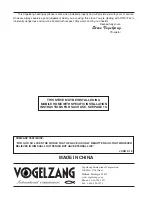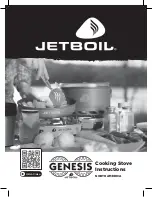
VGZ-031 / 20120619.1
www.vogelzang.com
TR007
PONDEROSA™ /
Page 11
MASONRY CHIMNEY
The chimney must be a code-approved, masonry
chimney with flue liner. Before using an existing ma-
sonry chimney, clean the chimney, inspect the flue
liner and make any repairs needed to be sure it is safe
to use. Make repairs before attaching the stove. The
connector stove pipe and fittings you will need to con-
nect directly to a lined masonry chimney are shown in
figure 10.
CHIMNEY CONNECTIONS
The stove must be connected to either a lined ma-
sonry or manufactured metal chimney built and tested
to the specifications listed on the previous pages.
Chimneys perform two functions:
1). As a means of exhausting smoke and
flue gases which are the result of fuel com-
bustion.
2). The chimney (only) provides “draft” which allows
oxygen to be continuously introduced into the
appliance, so that proper combustion is
possible. This stove relies on natural draft to
operate.
NOTICE: Always provide a source of fresh air into
the room where the stove is located. Failure to do
so may result in air starvation of other fuel burn-
ing appliances and the possible development of
hazardous conditions.
A stove
DOES NOT create draft. Draft is provided
by the chimney. To achieve proper draft your chimney
must meet the four minimum height requirements
detailed in figures 11–13.
If these minimum require-
ments are not met your stove will not operate
properly. A minimum of 0.05 w.c. (measured in water
column) is required for proper drafting to prevent back
puffing, smoke spillage, and to maximize performance.
(Gauges to measure draft are readily available at stove
stores and are economical to rent or purchase.)
Factors such as wind, barometric pressure, trees,
terrain and chimney temperature can have an adverse
effect on the draft. The manufacturer cannot be held
responsible for external factors leading to less than
optimal drafting.
Should you have a problem with inadequate draft,
you should contact a licensed heating and cooling con-
tractor for assistance in solving the problem.
For a more in-depth explanation see Chimney Draft
on page 18.
IMPORTANT Installation Points
1. Size chimney flue to stove collar. This stove
requires a minimum of a 6”/152mm diameter flue.
2. Never connect this unit to a chimney serving an-
other appliance.
3. The chimney must meet all minimum height require-
ments.
4. Never use a chimney to ventilate a cellar or base-
ment.
5. C o n t a c t y o u r l o c a l b u i l d i n g a u t h o r i t y
for approved methods of installation and any
necessary permits and/or inspections.
Figure 11 - Chimney Construction
through Attic Space
Figure 10 - Masonry Chimney Connection
If the connector stove pipe must go through a
combustible wall before entering the masonry chimney,
consult a qualified mason or chimney dealer. The in-
stallation must conform to local building and fire codes
and latest edition of NFPA 211 US or CAN/CSA-B365.
If there is a clean out opening in the base of the
chimney, close it tightly.
CHIMNEY
FLUE
5/8" TILE
CHIMNEY
LINER
MASONRY
CHIMNEY
THIMBLE
COLLAR
6˝ ROUND
24 ga. BLACK
CONNECTOR
STOVEPIPE
8˝ MIN.
LINER
BELOW
ENTRY
HOLE












































